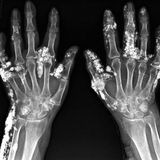


The Zollinger–Ellison Syndrome
A 75-year-old man presented to the emergency department with a 6-month history of epigastric pain, watery diarrhea, and weight loss. Physical examination was notable for epigastric tenderness. Esophagogastroduodenoscopy revealed severe esophagitis (Panel A), antral erosions, and duodenal ulcers (Panel B). The gastric pH was below 2, and the fasting serum gastrin level was above 1000 pg per milliliter (reference range, 13-115), findings that established the diagnosis of Zollinger–Ellison syndrome — a syndrome of gastric acid hypersecretion resulting from a gastrinoma. Treatment with a proton-pump inhibitor was initiated, and the patient’s abdominal pain and frequency of diarrheal episodes decreased. Computed tomography with positron-emission tomography identified a single tumor along the fourth part of the duodenum. Surgery with curative intent was performed, which included segmental duodenal resection and lymphadenectomy (Panel C; arrow indicates the tumor). Histopathological analysis showed a well-differentiated neuroendocrine tumor within a lymph node that was positive for gastrin on immunohistochemical staining (Panel D). Three months after the surgery, the fasting serum gastrin level was 44 pg per milliliter, and the findings on esophagogastroduodenoscopy were normal. A tapering of the proton-pump inhibitor dose was started, and the patient’s symptoms did not recur after the proton-pump inhibitor was discontined. Quentin Binet, M.D. Ivan Borbath, M.D., Ph.D. Cliniques Universitaires Saint-Luc, Brussels, Belgium source: nejm.org

